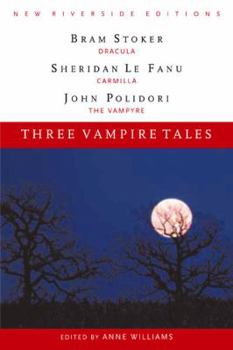Three Vampire Tales: Dracula, Carmilla, and the Vampyre
Three classic works of vampire literature come together for the first time in one volume. Complementing the complete texts are background essays as well as additional selections by the three authors... This description may be from another edition of this product.
Format:Paperback
Language:English
ISBN:0618084908
ISBN13:9780618084906
Release Date:February 2002
Publisher:Wadsworth Publishing Company
Length:481 Pages
Weight:1.14 lbs.
Dimensions:1.0" x 5.3" x 8.3"
Customer Reviews
5 ratings
good book
Published by Thriftbooks.com User , 15 years ago
This was what I was looking for, so I ordered it. I'm a Prime member so I got it very quickly in the mail. :)
The Great 19th Century Vampires & Their Antecedents.
Published by Thriftbooks.com User , 19 years ago
"Three Vampire Tales" is a collection of 19th century vampire literature that follows the increasing popularity of vampires in English literature, from Lord Byron's 1812 poem, "The Giaour", to the culmination of that century's vampire tales in Bram Stoker's 1897 gothic horror novel "Dracula". The three featured stories are: John Polidori's "The Vampyre", the first vampire short story in English, published in 1819; "Carmilla" by Irish writer Sheridan Le Fanu, published in 1872 as part of Le Fanu's "In a Glass Darkly" collection; and Bram Stoker's mythic 1897 novel "Dracula". All three works are included in their entirety. "The Vampyre" concerns a taciturn, enigmatic vampire called Lord Ruthven, and Aubrey, a young naive aristocrat, who is at first pleased to have Ruthven as a traveling companion. In the course of their adventures on the Continent, Aubrey comes to understand Ruthven's predatory character. But Ruthven requests an oath of secrecy on his deathbed, to which Aubrey agrees, only to find himself in a dire predicament when Ruthven turns up again, very much alive. This is a good story once you acclimate to the somewhat overburdened prose style. Sheridan Le Fanu is the most accomplished stylist of these three authors, and "Carmilla" has a crisp, delicate style. It shares with "Dracula" the technique of "authenticating" the story by making it out to be a first-person documentation of the events in question. A prologue explains that the story was written more than a decade after the events described, by the woman who experienced them in her youth. The story tells of 19-year-old Laura, who lives on an estate in Styria, Austria, with her widowed father and 2 governesses. The family takes in a lovely, but oddly languid, young woman named Carmilla who was shaken up in a nearby carriage accident. Soon after, women in the surrounding countryside begin to die mysteriously, and Laura experiences strange visitations in the night. I won't say much about "Dracula" here, because I have said so much elsewhere. The novel has never gone out of print since its publication in 1897, and its continuing influence on literature, film, and popular culture is incalculable. "Three Vampire Tales" is not as limited as the title implies, however. After an informative introduction by editor Anne Williams, the first part of the book addresses other 19th century literary vampires and their influence on Polidori, Le Fanu, and Stoker. This is interesting, because that century's vampire stories are closely related. For those who aren't familiar with the legend, I'll briefly describe the events of July 1816 at the Villa Diodati on Lake Geneva to which so much of the 19th century's vampire literature can be connected by some means: Lord Byron, his personal physician John Polidori, poet Percy Shelley, and his wife-to-be, Mary Godwin were staying at the Villa and, on one rainy evening, entertaining themselves by reading poetry aloud. After the recitation of Samuel Taylor C
Before Bram Stoker's Dracula...
Published by Thriftbooks.com User , 20 years ago
There was John Polidori's The Vampyre and Sheridan Le Fanu's Carmilla. This book has all THREE plus chapters that trace early appearances of vampires in literarty works and chapters that focus on Stoker's research into and his creative use of vampire sources. Also the cancelled chapter never used in Dracula, called "Dracula's Guest", which is a story all by itself. To wrap up the book there is a list of vampire films, listed by year, in the back. Very detailed, very complete - perfect as a gift or just an addition to any vampire library.
Great compilation.
Published by Thriftbooks.com User , 20 years ago
Dracula is a classic that is worth the price of admission by itself. But when you add Carmilla, Vampyre, and the other little extras then it becomes a must buy for any fantasy or vampire fan. Pick it up. You wont be sorry.
An unprecedented resource
Published by Thriftbooks.com User , 20 years ago
A note from the editor (Anne Williams): This volume brings together the texts needed to follow the evolution of the vampire through the nineteenth century. The vampire first appears in Lord Byron's "The Giaour," a bit of folklore he picked up when traveling in Greece. The first vampire tale in English emerges from the ghost-story-writing contest in 1816 that also produced "Frankenstein." Sheridan LeFanu's novella, "Carmilla" describes the dangers of a female vampire, a story which in turned influenced Bram Stoker, whose "Dracula" provided the archetype of the monster that has influenced countless movies and novels. This edition also contains an introduction speculating about the enduring appeal of this monster, a filmography, and critical and literary excerpts establishing the cultural context out of which the fantasy emerged.





